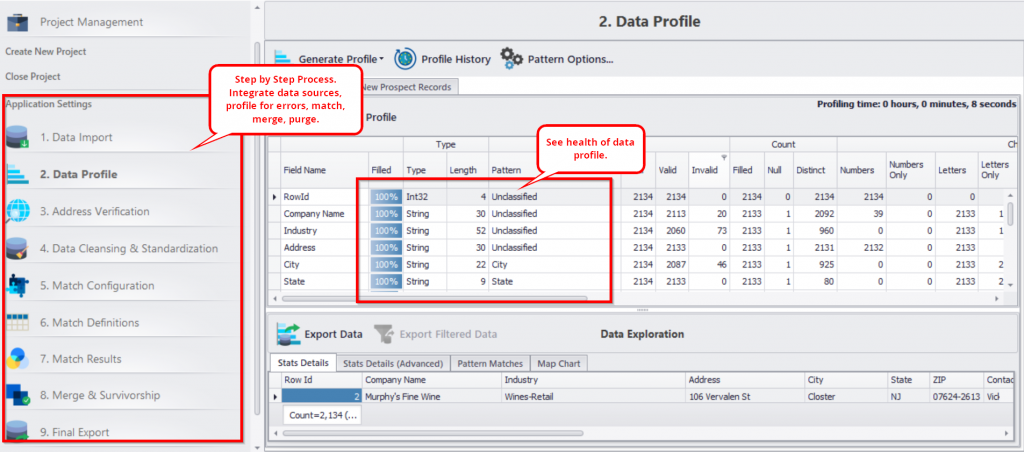Let’s face it – it’s embarrassing when you send out mails to the wrong audience set. More so, it is costly. Millions of dollars go to waste every year as companies struggle with maintaining their mailing lists. This is why a merge purge software is often an important tool in handling an organization’s mailing list dilemmas.
What exactly does merge and purge tools help you with and how do you benefit from using them? Here’s a quick rundown.
The Challenge of Data Quality
Prospect & customer data is the most important asset an organization owns. But simply owning data is not enough – the data must be fit for its intended use. Unfortunately, nearly 60% of business users believe their overall data health is unreliable.
Dirty data is not just a catchy phrase anymore, neither is it a simple matter of using ETL rules to turn all small letters into caps or to remove exact duplicates. Today, data is complex and so is the nature of its inaccuracies.
Take for example, mailing lists. Not only do you have to manage address data, but also phone data, email data, social media data and much more. Moreover, if you segregate your lists according to departments and functions, you have to deal with a much more complex set of data. The problem is, most of this data may be unstructured, messy and heavily duplicated.
It’s not uncommon for companies to use multiple apps and tools to store customer information. Most of this information either remains siloed or it is left unattended. Day in, day out, marketers and customer service reps work with outdated, incorrect data – half the time, they also have to manually fix that data!
This is where the need for a merge purge software comes in.
The Importance of Merge Purge Software & Complexities of Duplicates
A merge purge software is basically a tool that allows you to merge data from one source or multiple sources and eliminate duplicate records.
Now, there are dozens of tools out there that promise to do exactly this, however, very few of them are able to pull of the task.
The reason is the complexity of duplicates.
Basic tools only highlight or remove deterministic or exact matches duplicates. Take a look at the example below:
This is a deterministic duplicate. Everything is the same, only the year of birth is different. Basic tools will catch this in a fly.
| Name | DOB | Email Address | Phone | Address |
| John Senior | 14-09-1956 | John.senior.56@gmail.com | 361-306-8877 | 165 Washington Street |
| John Senior | 14-09-1959 | john.senior.56@gmail.com | 361-306-8877 | 165 Washington Street |
Now, look at the example below:
These are probabilistic duplicates, and these are the hardest to weed out. You will need a merge and purge tool that can identify these duplicates based on fuzzy matching algorithms (and in the case of DataMatch Enterprise, a combination of established algorithms plus proprietary algorithm).
| Name | DOB | Email Address | Phone | Address |
| John Senior | 14-09-1956 | John.senior.56@gmail.com | 361-306-8877 | 165 Washington Street |
| John F.Sr | 13-09-1956 | john.senior.56@outlook.com | 361-206-5577 | Corpus Christi, TX |
In this particular case, the user’s name now has a middle alphabet, plus, a shorter form of Senior. The DOB is wrong. The phone number has been changed and the address is incomplete. Basic merge/purge tools will have a tough time finding this as a match – more so if this duplicate occurs in multiple data sets.
The above example has been much simplified, but the fact remains that duplicates are becoming increasingly complex to resolve. There is no way to prevent it from happening, so it’s only wise to invest in a best-in-class merge and purge tool that can help you manage it better.
How Does a Merge Purge Tool Work?
Your mailing list does not necessarily come from one source. It’s quite probable that you’d need lists from marketing and customer support – say you want a mailing list of a specific segment of customers who are your top online purchasers and who are also your most active social media users. For this, you’ll need records from multiple departments, and it is here, that you will most likely encounter duplicates.
Depending on the tool you choose, you will be able to match mailing data between, across, and within data sets. DataMatch Enterprise, for example, offers merge and purge by letting users first profile their data to determine errors, clean those errors, and then run it through the matching function to remove duplicates. Once duplicates are removed or purged, you can then merge your data records into a final master record that you can use to begin your mailing activity.
Why Use a Tool Over a Team?
Duplicates are a constant problem and you’ll always need to fix them. Every time you update your mailing list, you’ll need a solution that you can just plug data into and get the job done.
Over the years, we’ve met multiple business leaders who tried hiring a team to merge purge duplicates – but sadly failed.
You see, data duplication, merging/purging of lists etc., are mundane tasks that can now easily be done via automation. What takes a team months to resolve, takes an efficient tool just minutes. Imagine, being able to merge and purge millions of rows of data in less than 30 minutes. Imagine, being able to do this repeatedly, creating new and updated records for every intended use. Imagine, being able to do this with all kinds of data sources within the organization.
Hiring a team may feel like an accomplishment, but overall, this will derail your team’s morale. Your data scientists and analysts are not for fixing data errors – they are there to help you manage your data better, derive key insights from it and build a solid data-driven organization.
To Conclude
Don’t want to make embarrassing mistakes? Need to sort your mailing lists and target your audience better? Use a best-in-class merge and purge tool & give your teams the opportunity to work with data they can trust.















































